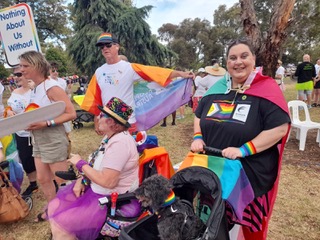15 May 2025
Author: Shannon Meilak
It seems that everywhere we turn, events are advertising themselves as accessible and inclusive, but what does that really mean in 2025 and is it just tokenism?
Last year, I attended Ability Fest for the first time. Launched seven years ago, it’s a great example of how festivals and events can be made more accessible. With chill zones and sensory rooms, AUSLAN interpreters, tactile flooring, and wheelchair friendly porta-loos, the festival demonstrates its commitment to continued access improvements. But whilst Ability Fest sets a standard of what true access and inclusion can look like, many more have missed the memo.
As a disabled and neurodivergent person, I actively seek out and attend inclusive community events whenever possible. Unfortunately, my experiences have been overwhelmingly mixed, leaning more toward frustration and disappointment. Whilst my observations are based in Melbourne, I am certain they resonate with disabled individuals across Australia.
In February, I participated in the Midsummer Pride March—an annual highlight on my calendar— although accessibility can be difficult. Being a Summer festival, the organisers do provide a shaded marquee at the starting point—a welcome relief from Melbourne’s scorching sun. The marquee has ample seating, and there is a ramp off the curb to enter Fitzroy Street for the march itself.

Large-scale events like this have come a long way, but there’s still room to grow. Ensuring adequate ramps and seating at the end of the March, would encourage community connection for people with disability. It would also go a long way in making the celebration feel just as inclusive for disabled attendees, as it did at the start. A shuttle service or much closer drop-off and pick-up points would also be welcomed.
Reaching out to Midsummer, I had a productive chat with one organiser who reported that my experience and recommendations would be included in their official report. Whilst this response was welcomed, it remains frustrating that such basic accessibility issues required advocacy rather than being addressed from the beginning.
These problems are not unique to large-scale city events. Local community festivals also routinely fail disabled attendees. I recently had a community member share their experience of a festival where her husband, a wheelchair user, was unable to navigate to the men’s toilets. He was forced to use the women’s facilities while volunteers stood guard to prevent women from entering. The indignity of this situation speaks volumes—how, in 2025, do we still lack basic accommodations that preserve disabled people’s dignity and autonomy?
So, what can events and festivals do to better include people with disability? A great starting point is looking at what events like Ability Fest are already doing right. Tactile flooring, accessible toilets, sensory spaces, and adequate seating, are all inclusions that will make an event more accessible. Beyond infrastructure, organisers can co-design their events, or at least, consult with us about our needs. We are after all, experts in our needs. Yet, despite being most affected by accessibility decisions, we’re often left out of decisions.
We live in an era where inclusion is often mocked as “woke” overreach and where diversity hires are dismissed as unnecessary. So then why are we still fighting for equitable access? How is it that long established, ‘inclusive’ organisations, and highly paid diversity and inclusion bureaucrats fail to recognise these barriers? Why must we continue the fight for access to our very own communities?
True accessibility is not about gestures or bare-minimum efforts. It’s about ensuring that disabled people can attend and enjoy events without unnecessary hardship, embarrassment, or danger. Until organisers fully grasp this, their claims of inclusivity will remain just that—claims, rather than meaningful action.
About the author:
Shannon is a disabled and neurodivergent creative with a strong focus on advocacy, accessibility, and authentic storytelling. Living with multiple disabilities has shaped her perspective and fuels her commitment to challenging ableism and creating inclusive spaces. Through her work in television, radio, writing, and community engagement, Shannon uses her lived experience to amplify voices that are too often excluded, driving meaningful change and fostering a culture of belonging.
PWDA members are the heart and soul of our organisation. We encourage all people with disability, residing in Australia to join our community of thousands of people with disability across Australia.
Ends | Contact Us
